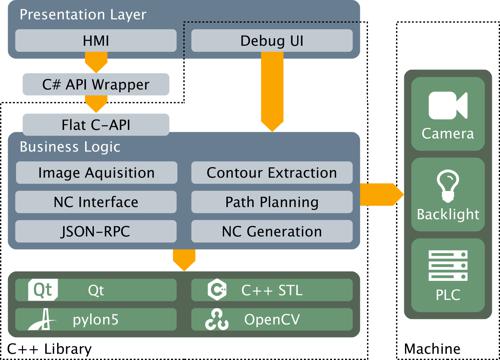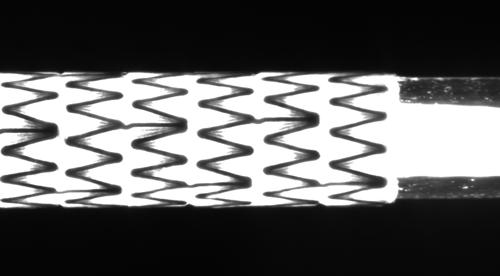Machine Vision Aided Laser Processing for Stent Manufacturing
- Degree programme: Master of Science in Engineering
- Author: Jan Lochmatter
- Thesis advisor: Prof. Andreas Habegger
- Expert: Rico Zoss (ANNAX Unternehmensgruppe)
- Industrial partner: BW-TEC AG
- Year: 2018
Stents are a key element in modern angioplasty. Stents are tube-like expandable wire meshes which are placed in narrowed vessels and ensures that the vessel remains open. Polymer coats allow drug elution at the cost of increased manufacturing complexity. Our machine vision system supports the automation of the laser cutting and welding process to cut the coat to its precise shape.
Motivation
Traceability and reproducibility are two major keys of today’s medical device manufacturing. Both issues are simultaneously addressed by an increase in the automation level along the manufacturing process. The Institute for Human Centered Engineering (HuCE) in cooperation with the Swiss-based company BW-TEC take efforts to increase this automation level for the production of coated stent grafts. Therefore, the Laser Welding Machine (LWM 1410) developed by BW-TEC serves as an appropriate research and automation platform for this thesis.
Goal
The process automation of coated stent grafts requires the integration of a machine vision system into the LWM. This allows to cut each graft based on its unique contour. The integration of this system requires three major modification to the LWM: First, extension of the machine firmware on the programmable logic controller (PLC); second, development of a C++ library providing the new features to the existing human machine interface (HMI); and third, integration of a lighting solution to illuminate the stents with high intensity.
System Integration
The LWM uses a CO2 laser and two motion axes to process the stent coat. The PLC firmware provides machine control through a numerical control (NC, G-Code) interface. An additionally implemented remote procedure call interface (JSON-RPC) enables access to machine parameters. The PLC is connected to the machine PC by a network layer (TCP sockets). The PC hosts the HMI and the machine vision algorithms. The stent contour extraction algorithm is developed in a dedicated bachelor thesis, in parallel to this MSE thesis. A LED filament based backlight solution located inside a glass tube provides bright light and simultaneously retains the stent during processing. A purposely developed driver circuit synchronizes the current to the exposure signal of the camera, preventing the LEDs from overheating.
Results
The existing NC communication protocol has already been used successfully beyond this thesis. The JSON-RPC protocol further simplifies the access to internal machine parameters. The library is able to control the machine functions and movement as well as the vision components. The provided API will allow integration into the existing HMI. The bright light of the LED filament based backlight results in high contrast images and supports the consecutive image processing.

